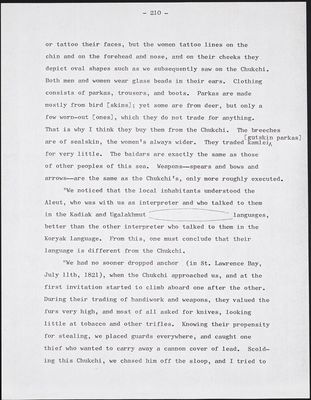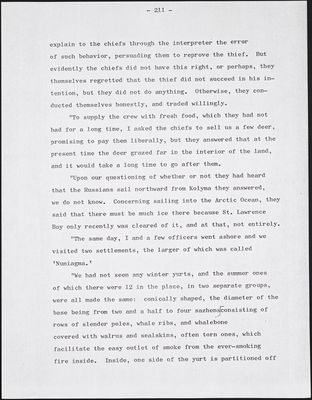Pages
mss142-vasilevShishmarev-i6-001
- 208 -
Chapter 6
Shishmarev's Article
This article by Shishmarev is apparently the only published account of the expedition dealing with a topical subject. It appeared in 1851, and except for the opening and closing paragraphs was taken directly from his journal.
Captain Shishmarev's Information about the Chukchi in 1821
In addition to information about the Chukchi of the northeast coast of Siberia collected by Plenisner (1765),1 Billings (1791), Sarychev (1791), and Litke (1828), we are adding information gathered by Captain Shishmarev on the sloop "Good Intent" in 1821 on St. Lawrence Island and in St. Lawrence and Mechigmenskaia bays during his famous expedition with Captain Vasilev in Bering Strait, described in Berkh's chronological history and in the article, "Russian voyages round the world" by G. Ivashintsov of parts VII and VIII of our journal.2 This information, in its comprehensiveness surpassing everything before it, is taken from Mr. Shishmarev's journal preserved in the archives of the Hydrographic Department.
"With good weather and a slight breeze from the WSW (on July 9, 1821), we succeeded, while sailing, in surveying
mss142-vasilevShishmarev-i6-002
- 209 -
the western part of St. Lawrence Island from a high steep southwestern cape that gradually slopes northward to a small harbor at the northwest cape, which is also steep but of moderate height. Here and there along the shore were settlements from which savages came to us in ten/baidars, numbering about 80 persons, including about ten women.
"The islanders, nearing our sloop, halted, and did not approach very closely to the side until they received our invitation. To begin a conversation and to gather information, I invited several onto the sloop and presented them with tobacco. In the boats they were so busy trading that they did not think of anything but tavaka (tobacco), which they asked for in exchange for every article, shouting at the top of their lungs, probably praising their merchandise. At first they bartered with us walrus tusks and walrus teeth, various knickknacks from walrus bone, and birds--murres, puffins, and sea doves [dovekies?]. We got in exchange so many birds that they sufficed the crew the whole day for food instead of salt beef. Then they traded us their weapons--and all this for tobacco, though they took our other things, too, but with reluctance.
"The inhabitants, generally, are of medium height, with black closely cropped hair, with a small crown left all round the head. Their faces are not very flat and their cheekbones not very pronounced. Their noses are short, but also not very flat, and their eyes are small and oblong. The women are shorter and have a more delicate color. The men do not paint
mss142-vasilevShishmarev-i6-003
- 210 -
or tattoo their faces, but the women tattoo lines on the chin and on the forehead and nose, and on their cheeks they depict oval shapes such as we subsequently saw on the Chukchi. Both men and women wear glass beads in their ears. Clothing consists of parkas, trousers, and boots. Parkas are made mostly from bird [skins]; yet some are from deer, but only a few worn-out [ones], which they do not trade for anything. That is why I think they buy them from the Chukchi. The breeches are of sealskin, the women's always wider. They traded kamlei [gutskin parkas] for very little. The baidars are exactly the same as those of other peoples of this sea. Weapons--spears and bows and arrows--are the same as the Chukchi's, only more roughly executed.
"We noticed that the local inhabitants understood the Aleut, who was with us as interpreter and who talked to them in the Kadiak and Ugalakhmut — languages, better than the other interpreter who talked to them in the Koryak language. From this, one must conclude that their language is different from the Chukchi.
"We had no sooner dropped anchor (in St. Lawrence Bay, July 11th, 1821), when the Chukchi approached us, and at the first invitation started to climb aboard one after the other. During their trading of handiwork and weapons, they valued the furs very high, and most of all asked for knives, looking little at tobacco and other trifles. Knowing their propensity for stealing, we placed guards everywhere, and caught one thief who wanted to carry away a cannon cover of lead. Scolding this Chukchi, we chased him off the sloop, and I tried to
mss142-vasilevShishmarev-i6-004
- 211 -
explain to the chiefs through the interpreter the error of such behavior, persuading them to reprove the thief. But evidently the chiefs did not have this right, or perhaps, they themselves regretted that the thief did not succeed in his intention, but they did not do anything. Otherwise, they conducted themselves honestly, and traded willingly.
"To supply the crew with fresh food, which they had not had for a long time, I asked the chiefs to sell us a few deer, promising to pay them liberally, but they answered that at the present time the deer grazed far in the interior of the land, and it would take a long time to go after them.
"Upon our questioning of whether or not they had heard that the Russians sail northward from Kolyma they answered, we do not know. Concerning sailing into the Arctic Ocean, they said that there must be much ice there because St. Lawrence Bay only recently was cleared of it, and at that, not entirely.
"The same day, I and a few officers went ashore and we visited two settlements, the larger of which was called 'Nuniagma.'
"We had not seen any winter yurts, and the summer ones of which there were 12 in place, in two separate groups, were all made the same: conically shaped, the diameter of the base being from two and a half to four sazhens/consisting of rows of slender poles, whale ribs, and whalebone covered with walrus and sealskins, often torn ones, which facilitate the easy outlet of smoke from the ever-smoking fire inside. Inside, one side of the yurt is partitioned off
mss142-vasilevShishmarev-i6-005
- 212 -
by poles and hung with skins, forming the warmest part, the bedroom.
"The baidars, the same as all of the inhabitants of both shores of Bering Strait, are all almost the same size with room for eight oarsmen and one helmsman.
"Their weapons are spears, bows and arrows. The spears are made mostly from wood with bone hafted on both ends, one end for animals, the other for men, but they have some of iron as well, received from Kolyma. The bows are bound with sinew, with arrows also from wood with bone or flint tips and feathers at the base. The bowstring is drawn on by a special plate of bone or iron. The quivers, sewn from deerskin, painted, and embroidered, are very pretty. But the main weapon is a large knife, about an arshin long, always carried with them and kept in a case, often likewise embroidered. Some have, in addition, one or two smaller knives, usually hidden in a pocket or behind a sleeve. We saw on one Chukchi, two muskets of English manufacture, probably received from Americans, because it is prohibited to sell firearms at the Kolyma fair.
"The men make small statues of men, animals, and birds from walrus bone, rather roughly however, and from wood--also in the likeness of men--small wooden boards which are rubbed to obtain fire. Women sew and embroider quivers, gloves, and other things, being much inferior in this art to the women of the Aleutian Islands.




